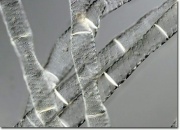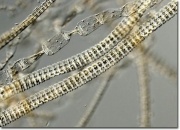Difference between revisions of "Algae"
(username removed) |
|||
| (6 intermediate revisions by 3 users not shown) | |||
| Line 2: | Line 2: | ||
== Description == | == Description == | ||
| − | A family of chlorophyll-containing organisms that grow in water. Algae range in size from microscopic, single cells (plankton, diatoms, flagella, etc.) to giant, multicellular forms ([ | + | A family of chlorophyll-containing organisms that grow in water. Algae range in size from microscopic, single cells (plankton, diatoms, flagella, etc.) to giant, multicellular forms ([[seaweed|seaweed]], [[kelp|kelp]]) over 100 feet long. They are abundant in salt and fresh water providing an important source of food for aquatic life. The four main types of algae are classified by their colors: brown, red, green and blue-green. Of the four, blue-green algae is considered detrimental. It grows in stagnant ponds and thrives on phosphorus compounds often making the water toxic to fish and other animals. Additionally, blue-green algae can form stains on damp building walls. The other types of algae are an important commercial resource and are used in the production of food, fertilizers, [[starch|starch]], [[agar|agar]], and [[carrageenan|carrageenan]]. They contain numerous minerals, vitamins, [[protein|proteins]], [[lipid|lipids]], and essential [[amino%20acid|amino acids]]. [[Algicide|Algicides]] are used to reduce or kill unwanted algae. |
[[File:zygnemalarge.jpg|thumb|Algae]] | [[File:zygnemalarge.jpg|thumb|Algae]] | ||
| + | |||
== Synonyms and Related Terms == | == Synonyms and Related Terms == | ||
| Line 12: | Line 13: | ||
<gallery> | <gallery> | ||
| − | File:Algae-01_ICOMOS.jpg|Algae | + | File:Algae-01_ICOMOS.jpg|Algae<br>Credit: G. Orial |
| − | File:Algae-02_ICOMOS.jpg|Algae | + | File:Algae-02_ICOMOS.jpg|Algae<br>Credit: V. Vergès-Belmin |
</gallery> | </gallery> | ||
| + | == Resources and Citation == | ||
| − | + | * ICOMOS-ISCS: [http://www.international.icomos.org/publications/monuments_and_sites/15/pdf/Monuments_and_Sites_15_ISCS_Glossary_Stone.pdf Illustrated glossary on stone deterioration patterns] | |
* Richard S. Lewis, ''Hawley's Condensed Chemical Dictionary'', Van Nostrand Reinhold, New York, 10th ed., 1993 | * Richard S. Lewis, ''Hawley's Condensed Chemical Dictionary'', Van Nostrand Reinhold, New York, 10th ed., 1993 | ||
| Line 27: | Line 29: | ||
* ''The American Heritage Dictionary'' or ''Encarta'', via Microsoft Bookshelf 98, Microsoft Corp., 1998 | * ''The American Heritage Dictionary'' or ''Encarta'', via Microsoft Bookshelf 98, Microsoft Corp., 1998 | ||
| − | * Wikipedia | + | * Wikipedia: http://en.wikipedia.org/wiki/Algae (Accessed Mar. 15, 2006) -for non-English terms |
[[Category:Materials database]] | [[Category:Materials database]] | ||
Latest revision as of 08:15, 26 April 2022
Description
A family of chlorophyll-containing organisms that grow in water. Algae range in size from microscopic, single cells (plankton, diatoms, flagella, etc.) to giant, multicellular forms (Seaweed, Kelp) over 100 feet long. They are abundant in salt and fresh water providing an important source of food for aquatic life. The four main types of algae are classified by their colors: brown, red, green and blue-green. Of the four, blue-green algae is considered detrimental. It grows in stagnant ponds and thrives on phosphorus compounds often making the water toxic to fish and other animals. Additionally, blue-green algae can form stains on damp building walls. The other types of algae are an important commercial resource and are used in the production of food, fertilizers, Starch, Agar, and Carrageenan. They contain numerous minerals, vitamins, proteins, lipids, and essential amino acids. Algicides are used to reduce or kill unwanted algae.
Synonyms and Related Terms
Spirogyra; alge (Dan., Nor.); Algen (Deut.); alga (Esp.); algues (Fr.) alghe (It.); algen (Ned.); glony (Pol.); algas (Port.); alg (Sven.);
Additional Images
Resources and Citation
- ICOMOS-ISCS: Illustrated glossary on stone deterioration patterns
- Richard S. Lewis, Hawley's Condensed Chemical Dictionary, Van Nostrand Reinhold, New York, 10th ed., 1993
- Van Nostrand's Scientific Encyclopedia, Douglas M. Considine (ed.), Van Nostrand Reinhold, New York, 1976
- Random House, Webster's Encyclopedic Unabridged Dictionary of the English Language, Grammercy Book, New York, 1997
- The American Heritage Dictionary or Encarta, via Microsoft Bookshelf 98, Microsoft Corp., 1998
- Wikipedia: http://en.wikipedia.org/wiki/Algae (Accessed Mar. 15, 2006) -for non-English terms



